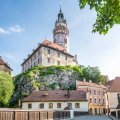On the hill of Český Krumlov, the imposing castle complex assembles volumes built around five inner courtyards and gardens that stretch out into the countryside. The second largest castle in the Czech Republic (the complex consists of nearly forty buildings) after Prague Castle, it shares with the latter impressive dimensions and a commanding location above the city and the Vltava River. The courtyards and other elements are connected by passages and footbridges that make the visit very entertaining. The city has always developed around the castle, according to the families who owned it. A small fortress founded in the middle of the 13th century by the Víkovici family, it was constantly enlarged to satisfy the ambitions and power of its rich owners. In 1302, the founding family died out. The period of the most important works began, carried out by the Rožmberk family, especially during the 16th century. It became the main residence of this family. Their emblem, a red rose, adorns many rooms of the castle. In the 18th century, the Eggenberk family (1622-1719) and the Schwarzenberg family (1719 onwards) carried out numerous Baroque renovations: construction of the Bellarie riding hall and belvedere, remodeling of the chapel, decoration of the carnival hall (prodigious trompe l'oeil of a masked ball with Pierrot, Harlequin and all the characters of the commedia dell'arte), construction of the new castle theater and the beautiful bridge (Pláštový most) formed by a three-story corridor supported by high piers.. In 1938, Krumlov was annexed to Austria by the Nazis, who expropriated the Schwarzenbergs. The Czech minority was expelled. In 1945, the city was liberated and the German population was in turn expelled. The Czechs from Krumlov and other parts of the country repopulated Krumlov.
Depending on how much time you have to devote to the visit, choose from one of the tours offered: one gives a complete overview of the original Renaissance and Baroque rooms, while another focuses more on the history of the Schwarzenberg family.
The first courtyard is characterized by a sloping ground. It was the center of local economic life under the Schwarzenbergs. It is surrounded by an old pharmacy (14th century, facades covered with sgraffiti), a hospital, stables from the 16th century, a gothic residence, an old farm, a dairy, a forge, a brewery. In short, a real small town in its own right. A stone bridge allows you to cross the moat. At the bottom of the moat, you will see bears. These animals are, by tradition and then by interest (big success with children), kept here in captivity since the 16th century! The moat is quite green, vast, but it is obvious that the animals are bored.
Past the plantigrades' pit, we reach the next courtyard, dominated by the 13th-century Gothic palace (Hrádek, transformed into a Renaissance palace in the 16th century). The tower that defended it has been elevated with beautiful arcade galleries. The Renaissance tower dominates the whole city and has become its symbol. Its elegance, the richness of its ornaments contrast with the high walls (40 m high) austere. You can climb up this round tower of the castle.
Around two slightly dark courtyards, this part of the castle has been continuously developed between the 14th and 18th centuries. Several rooms of the buildings which compose it can be visited. The most beautiful is the Salle des Masques. It was used for large balls and receptions, as shown by the superb trompe l'oeil paintings (1748) whose colorful and smiling characters invite to the party. In other rooms, furniture from different periods, a collection of tapestries from Brussels, or an impressive 17th century gilded coach. Don't miss a walk through the cellars, which are arranged on several levels. The cellars are named after Wenceslas IV who was imprisoned there in 1394. Today, they are frequently used to display ceramics by local and international artists.
Zámecké Divadlo You will have to "undertake" the crossing of the ravine to reach this other jewel of the Krumlov castle. It is a beautiful rococo theater built in 1680 by the Eggenbergs. It is exceptional and precious for the history of this art, because it has been perfectly preserved. Thus, the room, the sets, the costumes, but also the wooden machinery are the same as in the beginning. It still gives very popular performances.
Not far away is the former riding school, the " gateway" to the castle gardens. The gardens were laid out by Johann Christian von Eggenberg (who built the Baroque theater) and are a pleasant extension of the visit, with pavilions such as the rococo Bellaria pleasure pavilion, the music pavilion, a fountain with waterfalls, a winter riding school, and a vinarná around a large fireplace. Natural areas and formal flowerbeds are combined. The garden also houses a revolving theater, the setting for the summer festival. This is a surprising place: here it is not the stage that turns, but the spectators' stands.
Did you know? This review was written by our professional authors.
Book the Best Activities with Get Your Guide
Members' reviews on ČESKÝ KRUMLOV CASTLE
The ratings and reviews below reflect the subjective opinions of members and not the opinion of The Little Witty.

